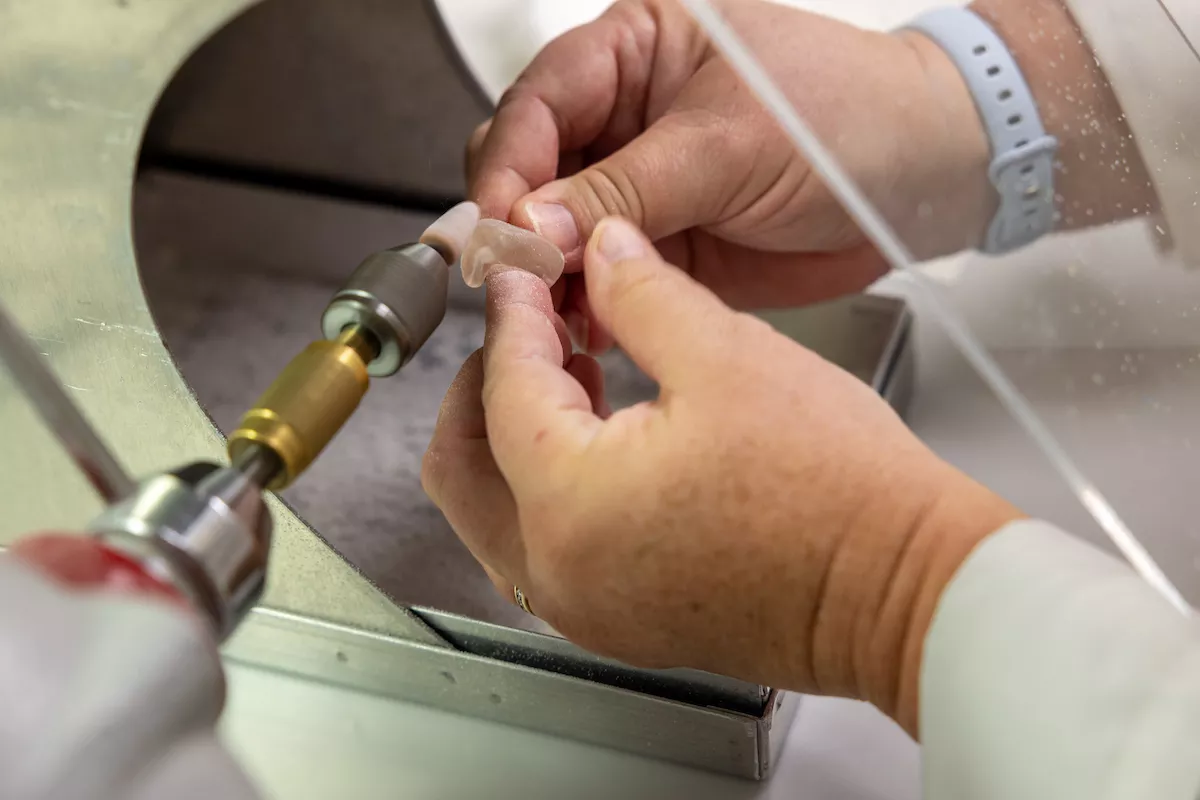Hearing Aids
- For all other requests:
- 1-800-777-8442
For many people, gradual hearing loss is a normal part of aging, but that doesn’t mean you should live with it. Untreated hearing loss can lead to feelings of depression and isolation, and it has been linked to cognitive impairment (difficulty thinking and remembering).
Fortunately, modern hearing aids and assistive listening devices can greatly improve your hearing—and your quality of life.
University of Iowa Health Care offers hearing devices to suit all your needs and preferences, including:
- Hearing aids equipped with the latest wireless or Bluetooth technology
- All styles of hearing aids
- Hearing aids across all price points, so you can choose one that helps your hearing and fits your budget
We also offer hearing devices for infants and children.
Our approach to hearing aid selection
Our goal is to help you find the best hearing solution that meets your individual needs.
When you choose UI Health Care’s hearing aid clinic, you receive one-on-one guidance and support from our audiologists (hearing loss experts). We’ll help you understand which hearing aids are best suited to your type of hearing loss and what factors you should consider before making your selection.
These factors include:
- Cost
- Comfort
- Cosmetic concerns
- Technology preferences
Once you choose a hearing aid, you’ll undergo a thorough fitting—and have ongoing follow-up appointments—to make sure it’s working properly. We offer a 30-day trial period to test your hearing aid.

Types of hearing aids available from UI Health Care
If you’re ready to address your hearing loss, we’re ready to help.
We offer a wide range of hearing aids from several manufacturers, including traditional and implantable options. We can also recommend assistive listening devices that you use instead of—or along with—your hearing aid.
Traditional hearing aids
Traditional hearing aids help you hear better by amplifying the sounds around you. They are wearable devices that you can easily take off or remove.
The main styles of hearing aids include:
- Devices worn behind the ear
- Devices that sit just inside your ear
- Devices that fit inside your ear canal
- Bone conduction hearing devices
All traditional hearing aids are now digital. Compared to older, analog models, they are better at picking up and processing sound—even in situations with a lot of background noise.
Many digital hearing aids are also equipped with wireless or Bluetooth capabilities that can connect with your cell phone or other devices.
Bone conduction hearing aids
Some people need a different type of hearing aid called a bone conduction hearing aid. These are also referred to by other names, including:
- Baha hearing aids
- ADHEAR
Bone conduction hearing aids don’t provide sound like traditional hearing aids. Instead, they help improve your hearing by sending sound waves through your skull and directly to your cochlea (the hearing organ inside your inner ear).
Most bone conduction options must be surgically implanted. Our otologists and neurotologists (ear disorder specialists) routinely perform these procedures.
Surgical solutions offered include:
- Baha Connect
- Osia
Assistive listening devices
Assistive listening devices (ALDs) are another type of hearing device that can be used alone or in conjunction with your hearing aids.
These devices include equipment that amplifies the sound of your phone, TV, or doorbell. You can also interact with (or control) some of them through your mobile phone.
If you’re interested in purchasing an ALD, we can make recommendations and connect you with a vendor who sells them.
Hearing aids for kids
Children also may benefit from hearing aids. Some infants are found to have hearing loss during their newborn hearing screening. Other children may develop hearing loss later in childhood.
If you want your child to communicate via spoken language, they should be fitted for a hearing solution by 6 months of age—or as soon as possible if they’re diagnosed at an older age.
Pediatric hearing aids work the same way as adult hearing aids. However, they’re designed to be safe, durable, and user-friendly—especially for young children. For example, hearing aids for children have features such as:
- Tamper-resistant battery doors (to reduce choking risk)
- Tamper-resistant volume controls
- Flashing lights that can alert you or your child’s teacher when the device is powered on or when the battery is getting low
We offer several types of pediatric hearing solutions, including:
- Behind-the-ear hearing aids: These sturdy, yet comfortable, hearing aids have a soft silicone earpiece. They come in a variety of colors.
- Baha Softband: This option fits around the head like a headband. It works well for kids who can’t wear a behind-the-ear hearing aid due to their ear anatomy or type of hearing loss.
- ADHEAR: This is a type of bone conduction hearing aid that doesn’t require surgery. It’s also a good option for kids who can’t wear a behind-the-ear hearing aid.
What to expect
Before you begin the process of choosing a hearing aid, we’ll need to determine what type (and degree) of hearing loss you have. We can either review your recent hearing test results from another provider, or you can undergo a new or first-time hearing test with one of our audiologists.
If we confirm that you would benefit from hearing aids, you can count on our team to help you make the best selection.
With so many hearing aids available, choosing the right one can feel overwhelming. Our team will help you find the device that’s right for you.
For example, we’ll help you figure out:
- Whether you have the dexterity needed to insert, remove, or change the volume on a small hearing aid
- Whether you have vision problems that could make it harder for you to clean certain types of hearing aids or replace tiny batteries
- If you’d also benefit from an assistive listening device, such as a TV streamer and remote microphone
Once your chosen hearing aid arrives, you’ll have another appointment called a fitting.
During this visit, we will make sure your hearing aid fits and works properly. We also will make sure you can hear a wide range of sounds at a volume that corrects your hearing loss. We use best practices for hearing aid fittings that include real ear measures. This helps us program the right settings for your device.
We’ll also teach you:
- How to insert or put on your hearing aid
- How to adjust the volume
- How to change or recharge the battery
- How to clean your hearing aid
Most people see us for follow-up visits two weeks after receiving their hearing aids, and then again at four weeks. We’ll discuss whether your hearing aid is helping, answer your questions, and (if needed) adjust your device settings.
Once you’re comfortable using your hearing aid, you’ll only need to see us once or twice a year for routine checkups.
Of course, we’re here to help anytime you notice a change in your hearing, or if your hearing aid needs repair.
Real ear measurement
Real ear measurement is a test that we use during your hearing aid fitting. Also known as probe microphone measurement and speech mapping, it’s considered the gold standard of hearing aid verification. It helps us confirm that your hearing aid(s) will deliver soft and loud sounds at the right amplification.
This improves your ability to understand speech.
This test takes place while you’re wearing your hearing aid. It includes the following steps:
We gently insert a tiny microphone into your ear canal while you listen to recorded speech samples at soft, moderate, and loud levels.
Your audiologist will adjust the hearing aid settings so they match targeted amplification levels across the full range of sounds.
If you have more than one hearing aid, we’ll perform the test in both ears. When we fine-tune your hearing aids with real ear measurement, we’re also factoring in the size and shape of each individual ear canal.
The following example illustrates the benefits of real ear verification:
- First, imagine looking at a picture that is fuzzy or out of focus. This “fuzziness” represents what you hear when you have hearing loss.
- Next, imagine that same picture has been adjusted so it’s clearer, but still not perfectly in focus. This represents how you might hear with a hearing aid that’s been programmed without the benefit of real ear measurement.
- Finally, imagine the picture is crystal clear. This represents your ability to hear with a hearing aid that’s programmed to your unique hearing thresholds and fine-tuned with real-ear measurements.
Our audiologists frequently perform real ear measurement during a new hearing aid fitting. However, we can also use it to test or adjust hearing aids you’ve been using for a while—regardless of where you purchased them.
We recommend real ear verification with every initial hearing aid fitting, and any time your device needs reprogramming (for example, after a significant change in hearing).
Our Care Team

- Otolaryngology

- Otolaryngology

- Otolaryngology





- Lindy Pelzer, ARNP
Wondering whether it's time for hearing aids?
Locations and Offices


